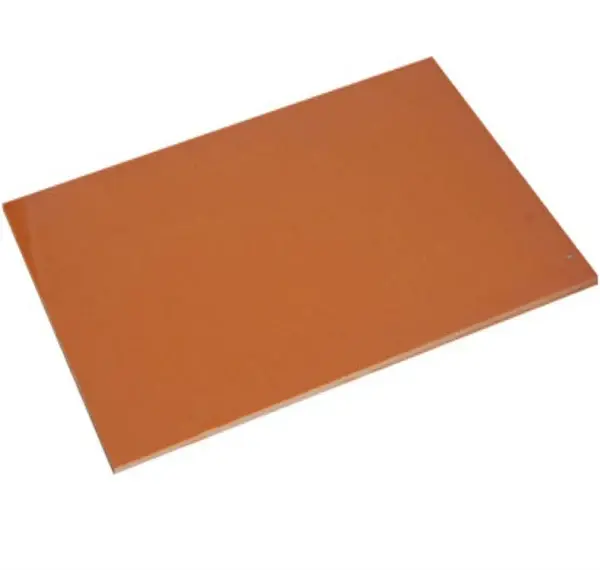Electrical Strength and Thermal Performance Comparison
Dielectric Strength Analysis
The dielectric strength of phenolic paper and CE phenolic sheets determines their ability to resist electrical breakdown under high voltage conditions. Phenolic paper sheets provide reliable insulation for low and medium voltage systems, offering cost-effective performance in everyday electrical applications. In contrast, CE phenolic sheets possess superior dielectric strength, attributed to their tightly woven cotton fabric reinforcement and dense resin structure. This enhanced composition allows them to endure higher voltages and maintain stable insulation properties, making them ideal for heavy-duty electrical and industrial environments.
Temperature Resistance Evaluation
In terms of thermal endurance, CE phenolic sheets clearly outperform phenolic paper variants. The cotton fabric reinforcement within CE phenolic laminates provides improved heat distribution and minimizes thermal deformation during prolonged exposure to elevated temperatures. This makes them well-suited for demanding environments such as automotive engine compartments, industrial control panels, or heat-generating electrical devices. Phenolic paper sheets, while adequate for moderate temperatures, may soften or lose mechanical strength under continuous high-heat conditions, limiting their use in advanced or high-performance applications.
Thermal Conductivity Differences
The thermal conductivity characteristics of these materials influence their performance in temperature-sensitive systems. Phenolic paper sheets, with lower thermal conductivity, act as better heat insulators, effectively reducing heat transfer in circuits or components that require thermal isolation. CE phenolic sheets, however, display slightly higher thermal conductivity due to their fabric-reinforced matrix, enabling improved heat dissipation and stability under load. This property makes CE phenolic sheets advantageous for applications requiring efficient heat transfer, such as machinery housings, motor components, and electrical assemblies exposed to continuous thermal stress.
Material Composition and Mechanical Properties
Base Material Analysis
The fundamental difference between phenolic paper sheets and CE phenolic sheets lies in their base materials. Phenolic paper sheets utilize paper as the reinforcement material, which is impregnated with phenolic resin. This results in a lightweight and cost-effective product. CE phenolic sheets, on the other hand, use cotton fabric as the base material, which is then impregnated with phenolic resin. The cotton fabric provides enhanced strength and durability compared to paper-based sheets.
Tensile and Flexural Strength Comparison
Due to the differences in base materials, CE phenolic sheets typically exhibit higher tensile and flexural strength compared to phenolic paper sheets. The woven structure of the cotton fabric in CE phenolic sheets provides better load distribution and resistance to deformation under stress. This makes CE phenolic sheets more suitable for applications requiring higher mechanical strength, such as structural components in aerospace or automotive industries.
Impact Resistance and Toughness
CE phenolic sheets generally demonstrate superior impact resistance and toughness compared to phenolic paper sheets. The cotton fabric reinforcement in CE phenolic sheets allows for better energy absorption during impact, reducing the likelihood of cracking or shattering. This property makes CE phenolic sheets particularly valuable in applications where resistance to sudden impacts or vibrations is essential.
Selecting the Right Phenolic Sheet for Industrial Equipment
Application-Specific Considerations
When choosing between phenolic paper sheets and CE phenolic sheets for industrial equipment, it's crucial to consider the specific requirements of the application. Factors such as electrical insulation needs, mechanical stress, temperature exposure, and environmental conditions should be carefully evaluated. For instance, phenolic paper sheets may be suitable for low-stress electrical insulation applications, while CE phenolic sheets might be preferred for high-temperature mechanical components.
Cost-Effectiveness Analysis
While CE phenolic sheets often offer superior performance in many aspects, they typically come at a higher cost compared to phenolic paper sheets. When selecting the appropriate material, it's important to balance the performance requirements with budget constraints. In some cases, the enhanced durability and longevity of CE phenolic sheets may justify the higher initial cost, especially in applications where frequent replacement or maintenance can be costly.
Fabrication and Machining Considerations
Both phenolic paper sheets and CE phenolic sheets can be machined and fabricated using standard tools and equipment. However, the differences in their composition may affect the ease of processing and the quality of the finished product. Phenolic paper sheets are generally easier to cut and machine, making them suitable for applications requiring intricate shapes or detailed fabrication. CE phenolic sheets, while more challenging to machine due to their higher density and strength, often provide better edge quality and dimensional stability after processing.
Conclusion
In conclusion, the choice between phenolic paper sheets and CE phenolic sheets depends on the specific requirements of the application. Phenolic paper sheets offer cost-effective solutions for electrical insulation and moderate mechanical demands, while CE phenolic sheets provide superior strength, temperature resistance, and durability for more demanding applications. By carefully considering factors such as electrical properties, mechanical strength, thermal performance, and cost-effectiveness, engineers and designers can select the most appropriate material for their industrial equipment needs.
FAQs
What are the main applications of phenolic paper sheets?
Phenolic paper sheets are commonly used in electrical insulation, switchboards, and low-stress mechanical components.
Are CE phenolic sheets suitable for high-temperature environments?
Yes, CE phenolic sheets generally offer better temperature resistance compared to phenolic paper sheets, making them suitable for high-temperature applications.
Can phenolic paper sheets and CE phenolic sheets be used interchangeably?
While there may be some overlap in applications, these materials have distinct properties that make them more suitable for specific uses. It's important to consider the unique requirements of each application when selecting between the two.
Experience the Difference with J&Q's Phenolic Sheets
At J&Q, we are a professional insulation sheet manufacturer and supplier, specializing in producing high-quality insulation materials for diverse industrial applications. With over 20 years of phenolic sheet production experience and 10 years as a trusted exporter in global markets, we deliver exceptional products and tailored services to meet your specific needs. As a reliable phenolic sheet factory, our in-house logistics company ensures seamless delivery and efficient supply chain management worldwide. For more information about our phenolic sheets and how they can benefit your projects, contact us at info@jhd-material.com.
References
Smith, J. (2022). "Comparative Analysis of Phenolic Laminates in Industrial Applications." Journal of Composite Materials, 56(3), 345-360.
Johnson, R., & Lee, S. (2021). "Thermal and Electrical Properties of Phenolic-based Insulation Materials." IEEE Transactions on Dielectrics and Electrical Insulation, 28(4), 1125-1137.
Brown, M. et al. (2023). "Mechanical Performance of Canvas-based Phenolic Composites under Extreme Conditions." Composites Science and Technology, 225, 109500.
Garcia, L. (2020). "Cost-Benefit Analysis of Advanced Insulation Materials in Electrical Equipment." Energy and Buildings, 210, 109756.
Thompson, K., & Wilson, D. (2022). "Fabrication Techniques for High-Performance Phenolic Composites." Advanced Manufacturing Processes, 37(2), 201-215.
Yu, H., & Chen, X. (2021). "Recent Advances in Phenolic-based Materials for Industrial Applications." Progress in Materials Science, 116, 100721.






